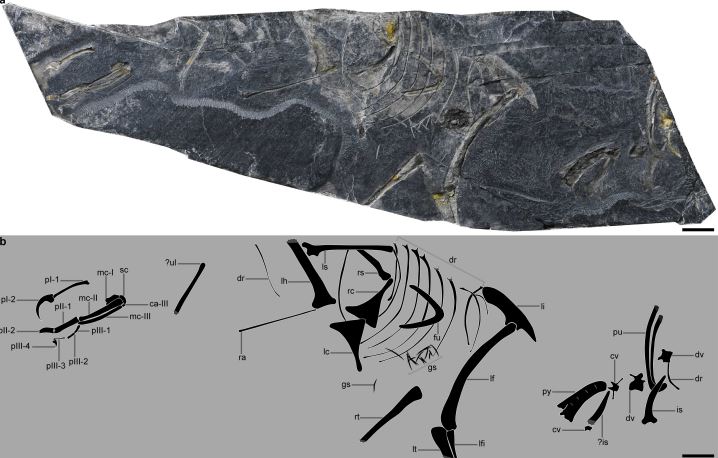Fuzhou: A short-tailed bird fossil, stated to be the oldest dating back about 150 million years, was discovered by Chinese scientists in east China’s Fujian Province shedding a new light on the origin of the birds, official media here reported Thursday.
The fossilised bird Baminornis zhenghensis was discovered in Zhenghe County, Fujian Province.
Its short tail ends in a compound bone called the pygostyle, a feature uniquely present in modern birds. This indicates that the body structure of modern birds emerged in the Late Jurassic Period, 20 million years earlier than previously known, state-run Xinhua news reported.
This suggests that birds might have originated earlier than previously thought, according to the report.
The bird displays a unique combination of traits, including modern bird-like shoulder and pelvic girdles, as well as a non-avian dinosaurs-like hand, which is a very interesting and contradictory phenomenon, Wang Min, a researcher with the Institute of Vertebrate Paleontology and Paleoanthropology (IVPP) under the Chinese Academy of Sciences (CAS), and the leading scientist of the research team said.
“This is a groundbreaking discovery. It overturns the previous situation that Archaeopteryx was the only bird found in the Jurassic Period,” claimed Zhou Zhonghe, an academician of CAS.
Based on the new discovery, scientists speculate that the emergence of the earliest birds could be traced back to an even earlier time, possibly 172 million to 164 million years ago, according to Wang.
The study, conducted by researchers from IVPP and the Fujian Institute of Geological Survey, was published in the latest issue of the journal Nature. While it is well established that birds evolved from dinosaurs, the timing of this transition has long been debated.
Some studies suggest that birds’ earliest diversification occurred during the Jurassic Period, though the fossil record has been sparse and fragmentary.
Archaeopteryx, often considered the earliest known and arguably the only Jurassic bird, has long been the focus of this debate. Although Archaeopteryx possessed feathered wings, it closely resembled non-avian dinosaurs, particularly due to its long, reptilian tail, which is in stark contrast to the short tails seen in modern birds, the report said.
Recent research has even questioned whether Archaeopteryx should be classified as a bird, suggesting instead that it may be more closely related to the deinonychosaurs, a group of theropod dinosaurs.
“If the avian status of Archaeopteryx is in question, the Baminornis zhenghensis is currently the most definitive Jurassic bird,” Wang claimed.
According to him, the shortening of the tailbone is one of the most profound morphological changes in the evolution from dinosaurs to birds.
The most distinctive feature of the Baminornis zhenghensis is its pygostyle. The emergence of the pygostyle is crucial for the forward shift of the body’s centre of gravity, the independent movement of the hind limbs and tailbone, and the refinement of flight capabilities, Wang said.
Scientists speculate that the Baminornis zhenghensis weighed around 100 grams, similar in size to a pet parrot, and lived in a swampy environment.
“Its shortened tail and more advanced structure in its scapula lead us to believe that its flying ability was superior to that of Archaeopteryx.
However, due to the incomplete fossil, we are unable to determine its exact flying posture,” Wang said. The researchers employed multiple methods to determine the position of Baminornis zhenghensis in the evolutionary tree of birds.
Their findings indicate that it is the earliest bird clade to diverge just after Archaeopteryx.
At the same site, scientists found another fossil consisting only of a furcula, or wishbone. Geometric morphometric and phylogenetic analyses identified it as belonging to Ornithuromorpha, a group of birds from the Cretaceous Period.
“The discovery of the two fossils indicates that at least two species of birds lived in the Zhenghe Fauna,” Wang said.
“These fossils point to an earlier origin of birds and suggest that birds most likely have radiated during the Jurassic Period,” Zhou said.
The fossils fill a gap in the early evolutionary history of birds, providing the strongest evidence yet that birds had begun to diversify by the end of the Jurassic Period, the scientists said.
“Baminornis is a landmark discovery, and ranks among the most important bird fossils unearthed since the discovery of Archaeopteryx in the early 1860s,” Xinhua quoted Stephen L. Brusatte, a paleontologist from the University of Edinburgh.
“Why did dinosaurs take to the skies and eventually evolve into the over 11,000 species of birds we have today? Such a major transition involved a series of changes,” Xu Xing, an academician of CAS and head of IVPP said.
“How were these changes in anatomy, physiology and behaviours across the entire body accomplished? We hope we can find more complete bird fossils, and even those with feathers, in the future so that our understanding of evolution becomes more comprehensive and profound,” Xing said.
PTI
